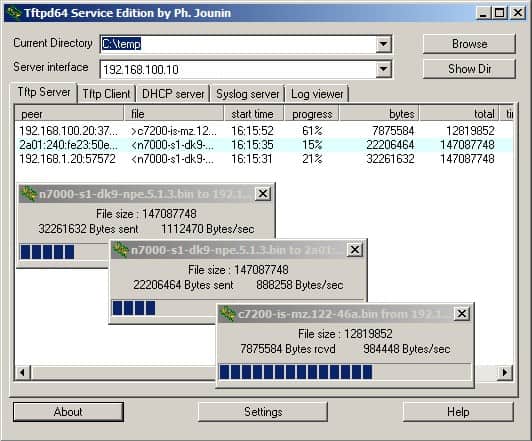Tftp Server For Mac

OS X Built-in tftp Server Apple OS X as an NFS Server (with Linux Clients) PhpStorm and Xdebug - macOS / Homebrew Asterisk with SS7 via Wanpipe, Dahdi and libss7 – with ISUP SAM support Switching Between PHP Versions on MacOS. Run a TFTP Server for Network Device Setups.on Mac OS X or macOS By Rick Cogley 6-Feb-2017 Software Tips Sysadmin TOC. PreparationFind appropriate commandsStart tftpdServe a Firmware FileSymlink the tftpboot folderCopy firmware file into posit.
Originally developed to recover missing or corrupted information by processing “par” and “par2” files, MacPAR deLuxe is able to unpack the data with its built-in unrar engine. Unrarx for mac.
TFTP, or Trivial File Transfer Protocol is a protocol that can be used for quickly shuttling files about. While similar to FTP, TFTP has no username and password (in most cases) and should not be running when you do not need it. It’s still in use today for a number of appliances such as routers and switches, to get firmware and occasionally configuration files.There’s a nice little GUI utility that can be used to house a TFTP server on Mac OS X. It’s funny enough, called TFTPServer. You can obtain it at http://ww2.unime.it/flr/tftpserver. Once you have downloaded it, you can open the application and you will be placed into the main application screen. By default, the TFTP server will share out the /private/tftpboot directory. If you’ve already got DeployStudio running then you’ve already got some form of tftp services that you can use and might already have some data in there.You can change the path (if you use DeployStudio with Windows clients you might not want to or you might break the PXE booting) by clicking in the currentpath field and typing the path to the directory you’d like to share out via TFTP. You can also click on the Change Path button to bring up a browse box.Once you are satisfied with the directory that you’re sharing out, click on the Start TFTP button. Then, once you’re complete with the tasks at hand that require TFTP go ahead and stop it again by clicking on the Stop TFTP button. If there are any problems with the TftpServer application accessing the data shared out then you will more than likely want to click on the Fix button at the bottom of the screen, which will likely be red. As with TFTP it’s really straight forward to use!You can also use the tftpd located in /usr/libexec, but most of the time you’ll just need a quick GUI to accomplish a task, which the TftpServer app is great for.Now as far as TFTP clients go, a number of devices can require you to TFTP into them to upload a configuration file or a firmware version. It can also be helpful for testing functions of the server that rely on TFTP. There is a TFTP command line client located in /usr/bin called appropriately tftp. You can use the get, put and quit verbs much as with other similar tools.There is also a GUI application for Mac OS X in Mac TFTP client. It’s somewhat dated, but still works. It has a Send and a Receive (Get) option. You simply put the name of the server, select the file and click start. Couldn’t be easier.Happy TFTPing!Solarwinds Tftp Server For Mac
An utility which helps you to utilize and configure the TFTP server shipped with the standard Mac OSX distribution. Using this application you can start/stop the TFTP service on your Mac. Why is that important? Well your already holding a running TFTP server on your hand, your MAC is already running a TFTP server, you just need to learn how to use it. MAC OS X Native TFTP Server. As I said it’s probably running anyway, but to check, open a Terminal window and issue the following command. TFTP Server v. Mac OS X has its own TFTP server, but every time I needed to start or reconfigure the TFTP service on a Mac I had to use the Terminal to issue some repetitive shell commands, thus I started to build this application as a simple AppleScript wrapper for the OS X's built-in TFTP service.